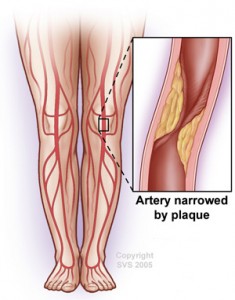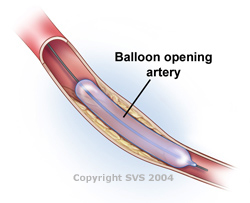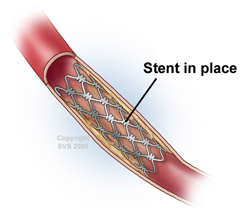Peripheral Artery Disease
 Peripheral artery disease, also known as peripheral vascular disease (PAD or PVD), is a serious vascular condition involving a buildup of plaque within the peripheral arteries of the legs and feet. Plaque is made up of fat, cholesterol, calcium, fibrous tissue, and other substances in the blood, and can accumulate as a result of several different factors. The buildup of plaque or blood clots can severely narrow or block the arteries and limit the flow of oxygen-rich blood to your body. It can lead to pain in the legs, either at rest or sometime only during walking (a symptom called claudication). It can also lead to wounds or ulcers on the legs or feet, poor wound healing, infections in the legs or feet, coldness or numbness of the legs and feet, and neuropathy type symptoms. In severe cases it can lead to gangrene and amputation of the toes, foot, or even amputation of the leg. Atherosclerotic plaque build-up often involves the legs, but can also affect the other arteries that carry blood from your heart to your head, arms, kidneys, and stomach. Fortunately, there are several treatment options available to relieve symptoms and prevent the disease from further progressing, including several life changes and minimally invasive treatments. Dr. Gotvald will discuss these options with you to determine the most effective treatment for your individual condition.
Peripheral artery disease, also known as peripheral vascular disease (PAD or PVD), is a serious vascular condition involving a buildup of plaque within the peripheral arteries of the legs and feet. Plaque is made up of fat, cholesterol, calcium, fibrous tissue, and other substances in the blood, and can accumulate as a result of several different factors. The buildup of plaque or blood clots can severely narrow or block the arteries and limit the flow of oxygen-rich blood to your body. It can lead to pain in the legs, either at rest or sometime only during walking (a symptom called claudication). It can also lead to wounds or ulcers on the legs or feet, poor wound healing, infections in the legs or feet, coldness or numbness of the legs and feet, and neuropathy type symptoms. In severe cases it can lead to gangrene and amputation of the toes, foot, or even amputation of the leg. Atherosclerotic plaque build-up often involves the legs, but can also affect the other arteries that carry blood from your heart to your head, arms, kidneys, and stomach. Fortunately, there are several treatment options available to relieve symptoms and prevent the disease from further progressing, including several life changes and minimally invasive treatments. Dr. Gotvald will discuss these options with you to determine the most effective treatment for your individual condition.
Causes and Risk Factors
Perpheral artery disease (PAD) develops as a result of atherosclerosis, which is a buildup of plaque within the arteries that narrows the vessel and restricts blood flow. PAD is also referred to as hardening of the arteries of the legs. It is most common in elderly patients with other medical conditions, such as diabetes, high cholesterol, high triglycerides, high blood pressure / hypertension, kidney disease, and heart disease, as well as those with a family history of these conditions. Other patients may be at a higher risk for developing PAD, including those who:
- Are Smokers or have smoked cigarettes or cigars in the past
- Are obese
- Are over the age of 50
- Do not exercise regularly
It is important for these patients to take certain precautions to reduce their risk of peripheral artery disease and other serious conditions. It is also important for those with risk factors to get the appropriate screening studies performed by a vascular specialist in order to check for the disease.
Symptoms
Many patients with periheral artery disease do not experience any symptoms and may not be aware that they have this condition, while others may experience:
- Pain or cramping in the hips, thighs, calves, or feet
- Numbness or weakness in the legs or feet
- Skin sores or ulcers on the legs or feet
- Hair loss
- Weak pulses in the legs or foot
- Coldness in the leg or foot
- Gangrene in the toes, foot, or leg
- Infections such as cellulitis or osteomyelitis (bone infection) in the legs or feet
Symptoms of PAD can vary significantly between patients, so it is important to see a knowledgeable vascular specialist in order to accurately diagnose this condition and to make appropriate recommendations for treatment and follow-up.
Diagnosis
Most cases of peripheral artery disease can be effectively diagnosed using a test called an Ankle Brachial Index (ABI), which compares blood pressure in your ankle to blood pressure in your arm to show how well blood is flowing in your limbs. While this test can determine whether or not there are blood flow problems within the legs, it cannot determine which specific blood vessels are affected. ABI is often performed as a screening test for PAD, but can also be used to determine the severity or progress of the disease. Additional testing to determine the specific blood vessels affected by this disease may include an angiography, which involves injecting a contrast dye into the bloodstream to watch blood flow through X-ray imaging assistance. Your doctor may also perform a Doppler ultrasound, blood test or magnetic resonance angiogram.
Treatment
Treatment for peripheral artery disease (PAD) aims to relieve symptoms and stop the progression of the disease to reduce the risk of a heart attack or other serious complications. Patients with mild forms of PAD may be able to effectively treat their condition through life changes, such as quitting smoking, eating a healthy, balanced diet and following a regular exercise plan. It is also important for patients, especially those with diabetes, to take good care of their feet. Your doctor may also prescribe medications to treat PAD, including those designed to:
- Lower cholesterol
- Lower high blood pressure
- Control blood sugar
- Prevent blood clots
- Relieve pain and other symptoms
For more severe cases of PAD, interventional or surgical treatment may be required to clear blockages and restore normal blood flow. Some of the most commonly used procedures for PAD include:
During this procedure, a catheter with a balloon or other device on the end is inserted into a blocked artery. The balloon is then inflated, which pushes the plaque outward against the wall of the artery. This widens the artery and restores blood flow.
Stents
A stent (a small mesh tube) may be placed in the artery during angioplasty. A stent helps keep the artery open after angioplasty is done. Some stents are coated with medicine to help prevent blockages in the artery.
Bypass Grafting
For this surgery, your doctor uses a blood vessel from another part of your body or a man-made hose to re-route or detour the blood around the area of blockage. This surgery doesn’t cure peripheral artery disease, but it tends increase blood flow to the affected limb and improve symptoms.










